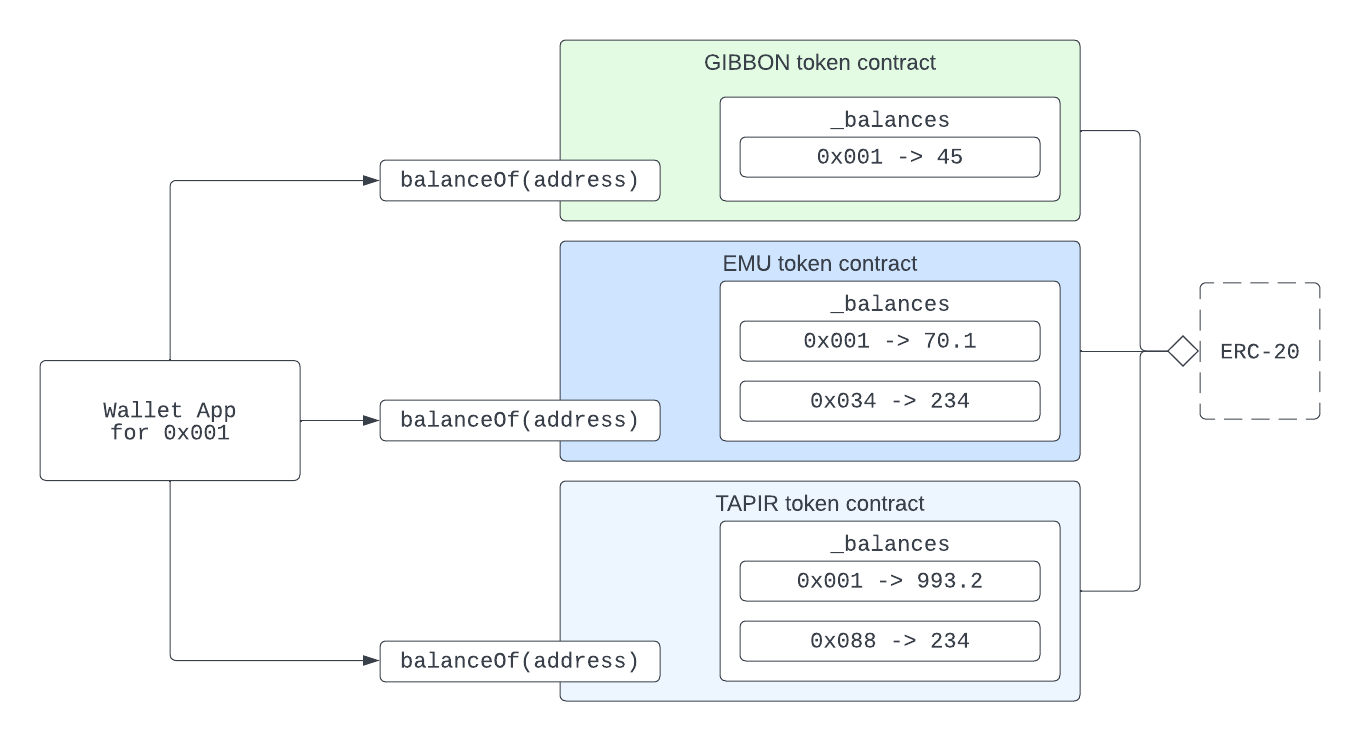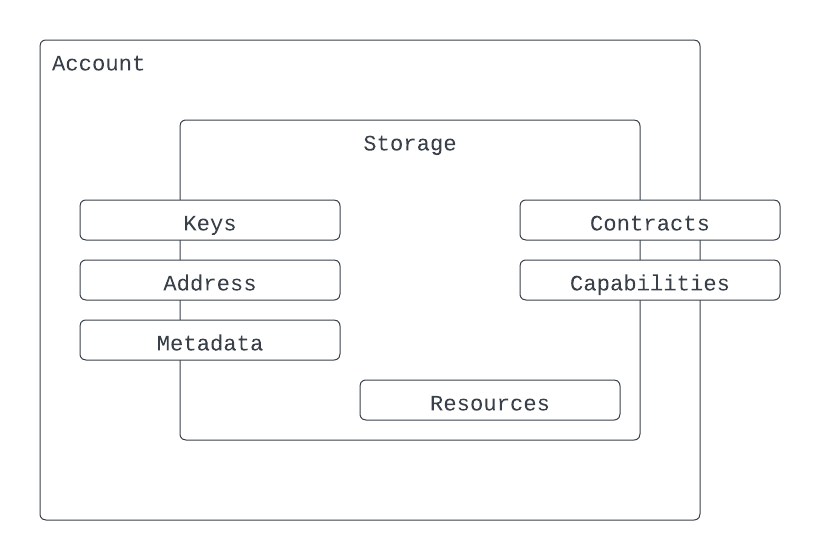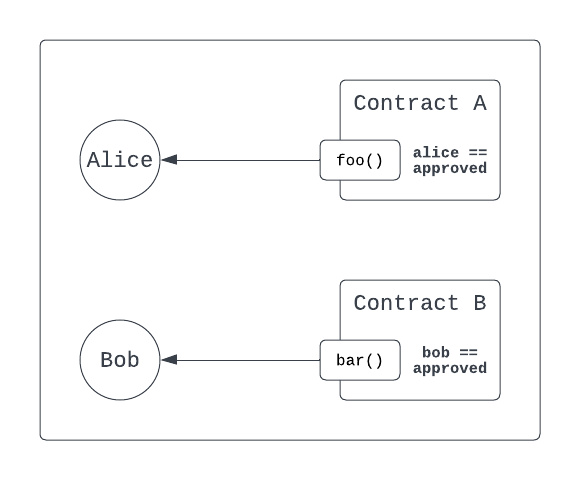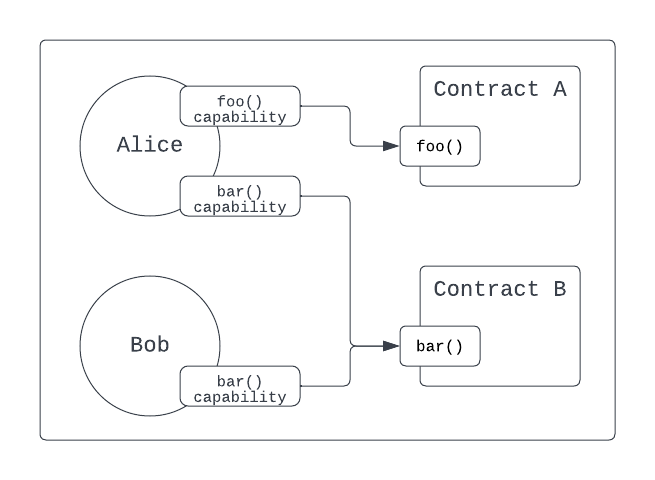Cadence introduces a different way to approach smart contract development which may feel unfamiliar to Solidity developers. There are fundamental mindset and platform differences, and also several new language features that have no real equivalent in Solidity. This guide outlines high level design and conceptual aspects of Flow and Cadence that are essential to understand, platform and integration differences, as well as detailed guidance on how to perform certain common Solidity development tasks using Cadence idioms. We also provide details on how best to leverage Cadence's unique features and how to avoid common pitfalls that may come up while transitioning.
Conceptual foundations for Cadence
A fundamental difference to get used to when adjusting to Cadence from Solidity is of mindset. Security and interoperability on Ethereum are designed around addresses (or more specifically the account associated with an address), resulting in all contracts having to carefully track and evaluate access and authorizations.

Transactions are based on who authorized them, which is provided as msg.sender in the transaction context.
User to contract, or contract to contract interactions must be explicitly coded to ensure the appropriate approvals
have been made before interacting with a contract. The contract based nature of storage means that user ownership
in Ethereum is represented in a mapping, for example from owner to balance, or token ID to owner. Put another
way, ownership is tracked in ledger records similar to a person's bank balance. Crypto wallets help combine
balances from multiple token types into a convenient view for the user.
Cadence introduces new primitives and distinct functionalities, namely Resources and Capabilities, that are designed around Flow's account model. Resources are first-class language types which are unique, non-copyable, and which cannot be discarded. These properties make Resources ideal for representing digital assets like currency or tokens that are always limited in numbers. Resources are always stored in account storage and contracts control access to them using Capabilities. Capabilities are another special type that secure protected resources without the need for tracking addresses. Cadence makes working with these straightforward and intuitive to those familiar with object-oriented programming languages.
Newcomers to Cadence should ensure they understand the following major concepts before development.
Flow account model
The Flow account model in Cadence combines storage for the keys and code (”smart contracts”) associated with an account with storage for the assets owned by that account. That’s right: In Cadence, your tokens are stored in your account, and not in a smart contract. Of course, smart contracts still define these assets and how they behave, but those assets can be securely stored in a user’s account through the magic of Resources.

There is only one account type in Cadence also with an account address, similar to an Externally-Owned-Account (EOA) address in Ethereum. However, unlike Ethereum contract-accounts, accounts in Cadence also store contract code. Accounts realize ownership on Flow in being the container where keys, Resources, and contracts are stored on-chain.
PublicAccount and AuthAccount
PublicAccount is the publicly available part of an account through which public functions or objects can be
accessed by any account using the getAccount function.
AuthAccount is available only to the signer of the transaction. An AuthAccount reference provides full access
to that account's storage, keys configuration, and contract code. Capabilities ensure that resources held in an account can be
safely shared/accessed; access to AuthAccount should never be given to other accounts.
Resources
Resources are unique, linear-types which can never be copied or implicitly discarded, only moved between accounts. If, during development, a function fails to store a Resource obtained from an account in the function scope, semantic checks will flag an error. The run-time enforces the same strict rules in terms of allowed operations. Therefore, contract functions which do not properly handle Resources in scope before exiting will abort, reverting them to the original storage. These features of Resources make them perfect for representing tokens, both fungible and non-fungible. Ownership is tracked by where they are stored, and the assets can’t be duplicated or accidentally lost since the language itself enforces correctness.
Flow encourages storing of data and compute on-chain and Resource-types makes this easier than ever. Since Resources are always stored in accounts, any data and code that exists in Resource instances is seamlessly managed on-chain without any explicit handling needed.
Capability-based access
Remote access to stored objects can be managed via Capabilities. This means that if an account wants to be able to access another account's stored objects, it must have been provided with a valid Capability to that object. Capabilities can be either public or private. An account can share a public Capability if it wants to give all other accounts access. (For example, it’s common for an account to accept fungible token deposits from all sources via a public Capability.) Alternatively, an account can grant private Capabilities to specific accounts in order to provide access to restricted functionality. For example, an NFT project often controls minting through an “administrator Capability” that grants specific accounts with the power to mint new tokens.
Contract standards
There are numerous widely-used contract standards established to benefit the ecosystem, for example Fungible Token(FT) and Non-Fungible Token(NFT) standards which are conceptually equivalent to Ethereum's ERC-20 and ERC-721 standards. Cadence's object-oriented design means standards apply through contract sub-types such as Resources, Resource interfaces, or other types declared in the contract standard. Standards can define and limit behaviour and/or set conditions which implementations of the standard cannot violate.
Detailed information about available standards and other core contracts can be found in Introduction to Flow.
NFT standard and metadata
Solidity must manage NFT metadata off-chain and NFTs typically link to IPFS JSON from on-chain.
The Cadence NFT standard provides in-built support for metadata with specific types called views. Views can be added to NFTs when minted and will always be available as part of the NFT. While metadata is stored on-chain, graphics and video content are stored off-chain. Cadence provides utility views for both HTTP and IPFS based media storage which remain linked to your NFT.
Using NFT metadata views is a requirement to get listed in the Flow NFT Catalog. Projects are encouraged leverage the NFT catalog since wallets and other ecosystem partners can seamlessly integrate new collections added there with no input from project creators.
NFT metadata on Flow opens the door to exciting new possibilities that help builders innovate. Check out this recent case study where a community partner leveraged SVG based metadata to make combined 2D + 3D versions of their PFPs, all on-chain inside the NFTs metadata!
Security and access control
Decentralized application development places significant focus on security and access and can fairly be described as security engineering. Understanding how Resources, Capabilities and the account model solve this may not be obvious when viewed from a Solidity perspective.
msg.sender considered harmful
The first question that every Solidity developer asks when they start programming in Cadence is:
"How do I get the account who authorized the transaction?"
In Ethereum this account is referred to as msg.sender and informs the program flow in a function depending on who
authorized it. Doing so is key to access and security, and is the basis of identity and ownership on Ethereum.
Cadence does not have msg.sender and there is no transaction-level way for Cadence code to uniquely identify the
calling account. Even if there was a way to access it, Cadence supports multi-sig
transactions, meaning that a list of all the signers' accounts would be returned, making it impossible to identify a single authorizer.

The reason msg.sender is both unsupported and strongly advised against is because Cadence uses Capabilities for
access rather than addresses. The mindset change that developers need to adjust to is that a capability must first be
obtained by the authorizing account (called provider or signer in Cadence) from the contract that will require it,
which then enables the requesting account to access the protected function or Resource. This means the contract never
needs to know who the signer is before proceeding because the capability IS the authorization.

The capability-based security model frames access in the opposite direction than the access-based security model.
Access control using Capabilities
Solidity lacks specific types or other primitives to aid with permission management. Developers have to inline
guards to require at every function entry-point, thus validating the msg.sender of the transaction.
Capabilities are defined by linking storage paths (namespaces for contract storage) to protected objects and then making that linked capability available to other accounts. Public and private scopes defined for storage paths and Capabilities themselves align precisely with PublicAccount / AuthAccount account scopes.
Any account can get access to an account's public Capabilities. Public capabilities are created using public paths,
i.e. they have the domain public. For example, all accounts have a default public capability linked to the
FlowToken.Vault Resource. This vault is exposed as a public capability, scoped to the FungibleToken.Receiver resource
interface, to allow any account to borrow() a reference to the Vault to make a deposit(). Since only the functions
defined under the [FungibleToken.Receiver](https://github.com/onflow/flow-ft/blob/master/contracts/FungibleToken.cdc#L105)
interface are exposed, the borrower of the vault reference cannot call withdraw() since it is scoped in the provider
interface. Public capabilities can be obtained from both authorized accounts (AuthAccount) and public accounts
(PublicAccount).
Private capabilities are specifically granted to accounts. They are created using private paths, i.e. they have the
domain private. After creation, they can be obtained from authorised account objects (AuthAccount) but not public
accounts (PublicAccount). To share a private Capability with another account, the owning account must publish it
to another account which places in the account inbox. The recipient can later
claim the Capability from the account inbox using then claim function.
Capabilities can be unpublished and can also be revoked by the creating
account.
To aid automation, events are emitted for publish, claim and unpublish actions completed for a Capability.
Detailed information can be found in Capabilities.
Hygiene factors for protecting value
While capabilities grant account access to a protected resource, it's still necessary to impose controls on value
accessed through them. For example, if your use-case requires delegating access to a FlowToken.Vault to
withdraw() funds, it's important to limit the amount. Tokens implementing FT/NFT standards are the primary type of
value being exchanged by accounts on Flow. The standard provides the primitives needed to implement capability
limiting best-practices.
Token isolation
All FTs reside in a Vault Resource and each different FT will exist as a separate Vault in an account. Similarly,
all NFTs implement a Collection Resource, in which those NFTs held by an account for that collection are stored.
Whenever access to the withdraw() function has to be delegated to another account, the simplest way to limit how
many tokens of a given type can be withdrawn is to create a new Vault Resource for that token type and move a smaller
amount of the tokens in the main token Vault. A capability is then linked to that Vault instance before being
made available to another account.
A similar pattern can be used for NFTs, where a new Collection Resource can be created into which only those NFTs
which should be exposed are moved. A capability is then linked to that Collection instance before being made
available to another account.
Bespoke control strategies
For more complex use-cases one might create a new Resource that implements the relevant interfaces to match those of the protected Resource(s) which it wraps. The code for the new Resource can then enforce limits as required and control how and when delegation to the underlying resource occurs.
Admin roles
Compared to Solidity, creating an admin role in Cadence requires a little more code, all of which is encapsulated within a Resource. The admin object design can be highly customized and employ Capabilities for fine-grained control such as limiting access to individual functions, on a per-account basis if required. The complexity needed for admin roles may vary, for example, larger organizations may require more complex role-based-access schemes. The use of a Resource in this context is key - the instance can't be copied and the account with the first edition mint of the admin serves as the root-admin. The admin can be implemented to mint additional admin Resource instances, which only the root-admin can grant to selected user accounts via a Capability. Conveniently, because the admin role is only accessible via a Capability it's easy to manage with Capability Revocation.
The admin role originates from the init singleton pattern and uses the Capability Bootstrapping pattern for making the Capability available to other accounts.
An example admin role implementation is available in Cadence cookbook.
Role-based access
Implementing role-based-access can be achieved by defining roles as Resources managed by the root-admin account.
Roles can provide limited access to functions which guard other protected resources, with access levels and/or
what is exposed varying from role to role. The root-admin can grant accounts access to individual roles through a
private capability. Functions that the roles are permitted to invoke may be scoped as access(contract) to
enforce that they can only be called by code paths in the root-admin contract.
Other best practices and conventions
Certain well established best practices for Solidity may not apply or are handled differently.
Check effects interactions
Solidity contracts must use the check effect interaction because functions are public by default and address-based access means that guards must exist when program flow concedes control to an external contract. There are two reasons why this is significantly less of a problem in Cadence. Functions are private by default and the language provides a range of access scopes. More importantly, 'risks associated with ceding control to an external contract' is an Ethereum phenomenon; the risk no longer applies. This is primarily because Cadence contracts are not static singletons, so control is never lost to another contract during the scope of a transaction.
Guard Check
Solidity uses revert, require & assert to validate inputs. require is a product of the address-based nature
of Solidity which Capabilities replace. revert is similar to Cadence's panic in that a transaction is aborted.
Cadence provides an assert operator which mirrors assert in Solidity.
Modifiers
Modifiers are extensively used in Solidity when enforcing pre-checks within a function. This is a powerful language feature. However, modifiers can also mutate state which introduces risks to program control flow.
Cadence uses pre and post blocks to validate input values or the function execution outputs. Notably, pre and
post block prohibit changing of state and may only enforce conditions.
Another difference is that modifiers in Solidity can be re-used within the contract multiple times. Cadence
pre & post blocks are associated to individual functions only, reducing the likelihood of errors but which
results in a small amount of code duplication.
Error handling
Solidity offers try/catch block to handle errors, however, there is presently no equivalent in Cadence.
Integration differences
Scripts and transactions
Another major difference between Cadence and Solidity is that deployed contracts are not the only code being executed in the VM. Cadence offers scripts, of which a subset are transactions, and both permit arbitrary code. Scripts or transactions are not deployed on-chain and always exist off-chain, however, they are the top-level code payload being executed by the execution runtime. Clients send scripts and transactions through the Flow Access API gRPC or REST endpoints, returning results to clients when applicable. Scripts and transactions enable more efficient and powerful ways to integrate dapps with the underlying blockchain, where contracts can more purely be thought of as services or components, with scripts or transactions becoming the dapp-specific API interface for chain interactions.
Scripts are read-only in nature, requiring only a main function declaration and which perform
queries against chain state, eg:
_12// This script reads the balance field of an account's ExampleToken Balance_12import FungibleToken from "../../contracts/FungibleToken.cdc"_12import ExampleToken from "../../contracts/ExampleToken.cdc"_12_12pub fun main(account: Address): UFix64 {_12 let acct = getAccount(account)_12 let vaultRef = acct.getCapability(ExampleToken.VaultPublicPath)_12 .borrow<&ExampleToken.Vault{FungibleToken.Balance}>()_12 ?? panic("Could not borrow Balance reference to the Vault")_12_12 return vaultRef.balance_12}
Transactions are an ACID (Atomic, Consistent,
Isolated and Durable) version of scripts having only prepare and execute functions that either succeed in
full and mutate chain state as described, or otherwise fail and mutate nothing. They also support setting of pre
and post conditions. In the example transaction below ExampleTokens are deposited into multiple receiver
vaults for each address in the input map.
_37import FungibleToken from "../contracts/FungibleToken.cdc"_37import ExampleToken from "../contracts/ExampleToken.cdc"_37_37/// Transfers tokens to a list of addresses specified in the `addressAmountMap` parameter_37transaction(addressAmountMap: {Address: UFix64}) {_37_37 // The Vault resource that holds the tokens that are being transferred_37 let vaultRef: &ExampleToken.Vault_37_37 prepare(signer: AuthAccount) {_37_37 // Get a reference to the signer's stored vault_37 self.vaultRef = signer.borrow<&ExampleToken.Vault>(from: ExampleToken.VaultStoragePath)_37 ?? panic("Could not borrow reference to the owner's Vault!")_37 }_37_37 execute {_37_37 for address in addressAmountMap.keys {_37_37 // Withdraw tokens from the signer's stored vault_37 let sentVault <- self.vaultRef.withdraw(amount: addressAmountMap[address]!)_37_37 // Get the recipient's public account object_37 let recipient = getAccount(address)_37_37 // Get a reference to the recipient's Receiver_37 let receiverRef = recipient.getCapability(ExampleToken.ReceiverPublicPath)_37 .borrow<&{FungibleToken.Receiver}>()_37 ?? panic("Could not borrow receiver reference to the recipient's Vault")_37_37 // Deposit the withdrawn tokens in the recipient's receiver_37 receiverRef.deposit(from: <-sentVault)_37_37 }_37 }_37}
Transactions can encompass an arbitrary number withdrawals/deposits, across multiple FTs, sending to multiple addresses, or other more complex variations, all of which will succeed or fail in their entirety given their ACID properties.
Contract imports and dynamic contract borrowing
Contracts in Ethereum are similar to static singletons in that interactions happen directly between users and the functions declared on the contract instance itself. The object-oriented nature of Cadence means that contracts are more accurately viewed as imported dependencies. The imported contract makes its object graph available for the code at runtime. Rather than interacting with a contract singleton instance, account interactions to access capabilities are the primary integration entry point, allowing the user to interact with the returned objects.
Dynamic borrowing of a contract inlines the loading of a contract based on its contract address. The loaded contract can be cast to the contract standards it conforms to, eg: NFT standard, and then interacted with in the same way were it imported. Consider the implications of this for composability of contracts..
Detailed information about deploying, updating, removing or borrowing contracts can be found in Contracts
Multi-key, multi-signature support
Solidity supports only one kind of multi-signature scheme where n out of m (assuming m > n) approvals need to be obtained to execute the transaction from the multi-signature smart contract. The most used multi-signature smart contract in the Ethereum ecosystem is the gnosis safe contract. However, Solidity lacks support for signature aggregation or BLS signature schemes.
Cadence offers a wide range of options to implement various multi-signature schemes.
- Inherent support for multi-sign transactions.
- Resource transfer scheme.
- Inherent support of BLS signature scheme.
Flow account keys have assigned weights, where a 1000 unit weight is the cumulative weight needed from signing keys to execute a transaction successfully. One can divide weights across multiple keys and distribute those partial weighted keys to authorized signers. When signing the transaction, all signers must sign the transaction together in a short period of time in order for the cumulative weight to reach 1000 units.
See BLS Signature scheme for a detailed overview of the inherent support of BLS signatures.
Resource transfer scheme
The main limitation of multi-sig transactions is that signatures must all be made for the transaction within a relatively short time window. If this window is missed, the transaction will abort. The resource transfer scheme is very similar to the Solidity multi-signature smart contract. A Resource is created that has the functionality to proxy the execution of a fund transfer. This Resource is handed from one signer to the next to collect signatures. Once the threshold of required signatures is met the transaction is executed. The elapsed time The main drawback with this approach is that does not support execution of arbitrary functionality.
Other platform differences
The following differences unrelated to implementing Cadence contracts are useful to understand in the context of application design.
Events
Flow uses events extensively to provide real-time signals to off-chain systems about particular actions that occurred during a transaction. The main difference on Flow is that events remain part of the history and are not purged from storage. Events can be populated with arbitrary data that will assist consumers of the event. Builders are encouraged to leverage events for seamless UX as users perform transactions.
Contract upgradeability
Flow supports limited upgradability of Cadence contracts which is most helpful during development. The following function shows how an account owner can update a contract. Upgrades are analyzed for prohibited changes once uploaded for upgrade. Upgradeability is still an early phase feature, which will continue to improve over time.
_10fun update__experimental(name: String, code: [UInt8]): DeployedContract
To enforce immutability once a contract is tested and ready to deploy, account owners can optionally revoke keys from the account containing the contract.
Detailed information about the cadence upgradeability is available in Contract updatability.
Account key formulation
In EVM-based chains, an address is derived from a cryptographically generated public key and can have a single private key, supporting one type of signature curve, i.e. ECDSA. They are not verifiable off-chain and typos/truncation in an address may result in funds being lost.
Flow account addresses have a special format and are verifiable off-chain. Verifying address format validity can be done using an error detection algorithm based on linear code. While this does not also confirm that an address is active on-chain the extra verifiability is a useful safeguard.
Contract size constraints
Solidity developers will be well aware of the EIP-170 deployable contract bytecode size limit of 24KB. This can burden builders who need to optimize contract bytecode size, sometimes even requiring a re-design of contracts to break it into smaller contract parts.
By contrast, Cadence has no inherent or defined smart contract size limit. However, it is restricted by the transaction size limit which is 1.5MB. With very rare exceptions, it’s unlikely that this limit would pose a problem to those developing Cadence contracts. Should it be needed, there is a known way to deploy a contract exceeding 1.5 MB which we will document at a later time.
Low level language differences
Arithmetic
Historically, Solidity, smart contracts lost millions of dollars because of improper handling of arithmetic under/overflows. Contemporary Solidity versions offer inbuilt handling of under/overflow for arithmetic operations.
Cadence implements saturating math that avoids overflow/underflow.
Optional support
Optional bindings provide in-built conditional handling of nil values. Regular data types in
Cadence must always have a value and cannot be nil. Optionals enable variables / constants that might contain a
certain type or a nil value Optionals have two cases: either there is a value, or there is nothing; they fork
program flow similar to if nil; else; end;.
Iterable Dictionaries
Solidity offers the mapping type, however, it is not iterable. Because of that dApp developers have to maintain
off-chain tracking to be have access to keys. This also pushes builders to create custom datatypes like EnumerableMap
which adds to gas costs.
Cadence offers the Dictionary type, an unordered collection of key-value associations which is iterable.
Rich support for type utility functions
Cadence offers numerous native-type utility functions to simplify development. For example, the String type provides:
- utf8
- concat()
- slice()
- decodeHex()
- encodeHex()
- toLower()
- length
Argument labelling
Argument labels in Cadence help to disambiguate input values. They makes code more readable and explicit. They
also eliminate confusion around the order of arguments when working with the same type. They must be included in the function call. This restriction can be skipped if the label is preceded by _ on its declaration.
Eg:
fun foo(balance: UFix64)
called as
self.foo(balance: 30.0)
fun foo( _balance: UFix64)
can be called as
self.foo(balance: 30.0)
or as
self.foo(30.0)
Additional resources
- Cadence or Solidity: On-Chain Token Transfer Deep Dive
- Implementing the Bored Ape Yacht Club smart contract in Cadence